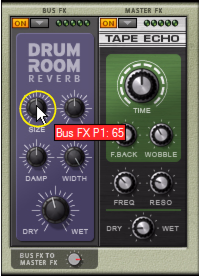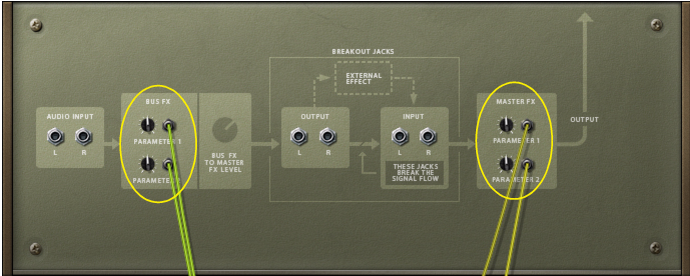When the FX modules are used in the Bus FX and/or Master FX slots, it is possible to route external CV signals to the first two Effect module parameters for modulation. If you hover with the mouse over the first or second parameter of an FX module loaded in the Bus FX or Master FX slot, a tool tip appears:
The tool tip shows which CV modulation input on the back of the unfolded Kong panel will control that parameter. For FX modules loaded in the Bus FX slot, the tool tip displays “Bus FX P1: nn” for the first FX module parameter and “Bus FX P2: nn” for the second one. For FX modules loaded in the Master FX slot, the tool tip instead reads “Master FX P1: nn” for the first FX module parameter and “Master FX P2: nn” for the second one. The “nn” in the tool tip indicates the current parameter value.
By connecting cables to the CV modulation inputs on the back of the Kong panel, you can modulate the corresponding FX module parameters in the Bus FX and/or Master FX slots.
If you decide to replace the FX modules in the Bus FX and/or Master FX slots, the modulation routing will be preserved - but the CV signals will now control the first two parameters of the replacement module(s).
The Drum Room Reverb is a reverb with a room-type reverb algorithm. It’s perfect for adding ambience to single drum sounds or to the entire mix of all 16 drum channels. The parameters are as follows:
|
•
|
|
•
|
|
•
|
|
•
|
|
•
|
The Transient Shaper is a type of dynamics processor which produces a result that could be compared to that of a compressor. As opposed to a “normal” compressor, the Transient Shaper mainly affects the signal’s attack, or transients in the signal, making the signal transients cut through in the mix. The parameters are as follows:
|
•
|
A positive Attack value will produce an amplified attack/transient whereas a negative value will reduce the attack/transient volume.
|
•
|
|
•
|
This controls the amplification amount. A high Amount in combination with a positive Attack value will produce a very pronounced attack/transient in the sound.
The Compressor levels out the audio, by making loud sounds softer. To compensate for the volume loss, the Compressor has a make-up gain control for raising the overall level by a suitable amount. The result is that the audio levels become more even and the sounds can get more “power” and longer sustain. The parameters are as follows:
|
•
|
This sets the sensitivity of the compressor. A high amount will make the compressor more sensitive and react to weak input signals.
|
•
|
This sets how fast the compression should be applied to the incoming signal. A low value will make the compression set in immediately whereas a high value will let the attack/transients through before compression sets in.
|
•
|
This sets how long it should take before the compressor lets the sound through unaffected again. Set this to short values for more intense, “pumping” compressor effects, or to longer values for a smoother change of the dynamics.
This sets the overall level compensation. A low value will produce a softer output signal whereas a high value will amplify the output signal.
The Filter is a state variable filter with a switch for selecting Lowpass, Bandpass or Highpass state. It has controls for cutoff/center frequency and resonance amount and can also be controlled from a built-in MIDI controlled envelope generator for sweeping the frequency. When used in the Bus FX Slot, MIDI Note E2 (#52) trigs the envelope. When used in the Master FX Slot, MIDI Note F2 (#53) trigs the envelope. The parameters are as follows:
|
•
|
This sets the amount of the MIDI controlled filter envelope. The Amount value is bipolar (+/-). Set to a positive value, the envelope will sweep the filter frequency from a high value down to the set Frequency value. Set to a negative Amount, the envelope will sweep the filter frequency from a low value up to the set Frequency value. The Amount is also affected by velocity.
The Parametric EQ is a single-band parametric equalizer with controls for center frequency, gain and bandwidth (Q-value). The parameters are as follows:
|
•
|
|
•
|
The Ring Modulator takes the input signal and multiplies it with an internal sinewave signal. The result is often a synthetic metallic sound. The Ring Modulator also features a MIDI controlled envelope generator for sweeping the internal sinewave frequency. When used in the Bus FX Slot, MIDI Note E2 (#52) trigs the envelope. When used in the Master FX Slot, MIDI Note F2 (#53) trigs the envelope. The parameters are as follows:
Sets the frequency of the internal sinewave oscillator. The higher the frequency, the higher the resulting output signal pitch.
|
•
|
This sets the amount of the MIDI controlled envelope. The Amount value is bipolar (+/-). Set to a positive value, the envelope will sweep the internal sinewave oscillator frequency from a high value down to the set Frequency value. Set to a negative Amount, the envelope will sweep the oscillator frequency from a low value up to the set Frequency value. The Amount is not affected by velocity.
The Rattler adds the effect of a snare “attached” to whatever sound is fed through it. Using the Rattler in combination with other types of sounds than “usual” snare drum sounds can produce really interesting results! Ever played a snare bass drum, or a snare hi-hat, for example? The parameters are as follows:
This sets the tension of the snare. Note that when the Snare Tension is increased, the effect will actually be less pronounced since the snare will have “less contact” with the sound source.
|
•
|
|
•
|
|
•
|
|
•
|
The Tape Echo is based on the principles of classic tape echo effects. The original tape echo effects were electro-mechanical devices that used an endless magnetic tape in combination with recording and playback heads inside the box. Depending on the speed of the tape, and on which playback heads were used, the echo repetition and echo patterns could be controlled. Later on, a lot of tape echo effects were replaced by digital delay effects. The Tape Echo in Kong simulates the classic tape echo effect and features the following parameters:
|
•
|
|
•
|
|
•
|
This sets the tape speed wobbling effect. Since it emulates a magnetic tape, a wobbling speed also automatically produces a wobbling pitch of the signal.
This sets the change in frequency of the delay repetitions. For every delay, the frequency content will shift according to the Frequency setting. A low value will make each repetition sound muddier than the previous one, whereas a high value will make each delay sound brighter.
This sets the resonance amount of the delay repetitions. Depending on the Frequency parameter setting above, different frequencies will be amplified.
|
•
|
The Overdrive/Resonator is a combined distortion and resonator module. It can be used to add a nice distortion to the input signal. There is also a resonator section with a number of selectable characteristics, similar to the Body section in the Scream 4 Sound Destruction Unit. The parameters are as follows:
|
•
|
|
•
|
|
•
|










